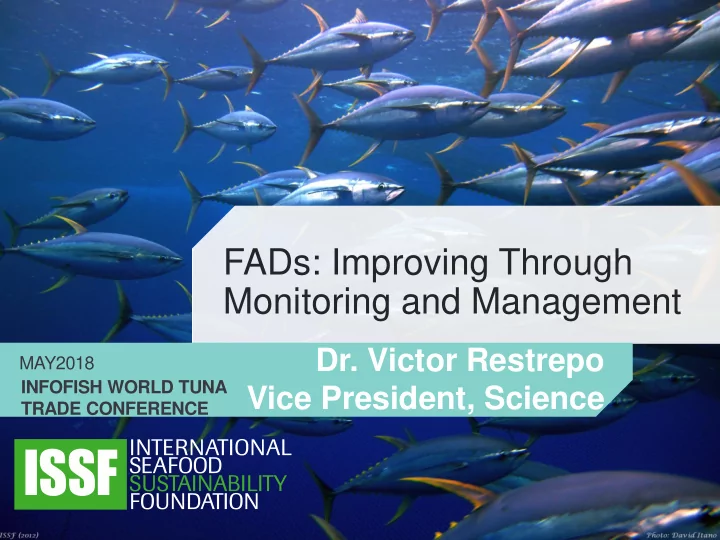

FADs: Improving Through Monitoring and Management Dr. Victor Restrepo MAY2018 INFOFISH WORLD TUNA Vice President, Science TRADE CONFERENCE
Introduction All fisheries need to be sustainably managed. FADs are part of the purse seine fishery. The entire fishery needs to be managed holistically 2
Sustainability (as per MSC Standard) • All types of fishing gears require active management and FADs are no exception . • Principle 1 (Sustainable fish stocks) . This depends on all fishing gears. Managing FADs alone won’t be enough. • Principle 2 (Minimizing environmental impact) . FAD sets tend to have higher bycatch. But free school sets also have impacts. • Principle 3 (Effective management) . The fishery as a whole needs to be monitored and managed. FADs are not the only element that needs MCS and governance. 3
Purse Seine Fisheries towards MSC Certification New ISSF report summarizes best practices for tropical tuna purse seine fisheries with FAD component that aim to participate in Fishery Improvement Programs (FIPs) w/ MSC certification objective Recommended practices linked to MSC Fishery Certification Requirements
The Details MSC Standard Principles: • For each Principle, there is a set of Performance Indicators (PIs). And for each PI, there are one or more Scoring Issues (SIs). • The report synthetizes the actions that the purse seine fishery needs to take (or to support) in order to achieve passing scores.
6 Best Practices to Manage FADs 7
6 Best Practices to Manage FADs 8
Additional FAD Reporting for Assessment Purposes Additional satellite buoy data (tracks, echosounder estimates of biomass, etc.) can be useful to scientifically analyze the impact of FAD fisheries and to improve stock assessments. Example: From IATTC WG on FADs
6 Best Practices to Manage FADs 10
6 Best Practices to Manage FADs 11
A More Sustainable FAD Considering the variety of designs and materials used in construction of FADs worldwide the ISSF Bycatch Steering Committee proposes a ranking of FADs according to the risk of entanglement associated with each design.
Embracing a Better FAD As sustainable fishing approaches, like using non-entangling FADs, become more familiar, fishers in ISSF skippers workshops express a growing acceptance of them over time, and RFMOs are making progress on sustainble FAD measures:
6 Best Practices to Manage FADs 14
6 Best Practices to Manage FADs 15
16
ISSF resource(s) — research, fisher workshops, videos, fisher guides, infographics, advocacy tools — and sometimes company conservation measures , support these best practices
Q & A 18
Recommend
More recommend